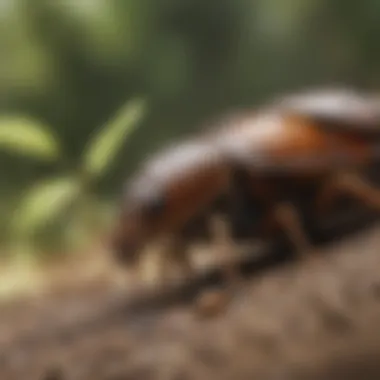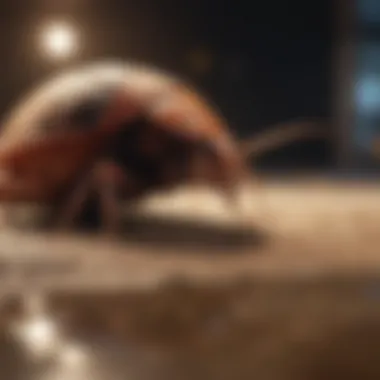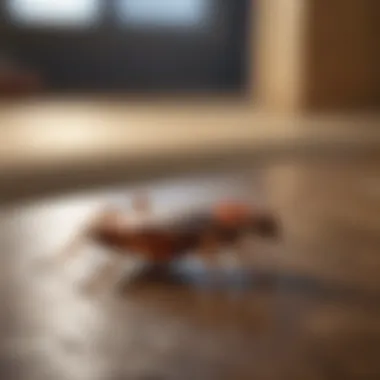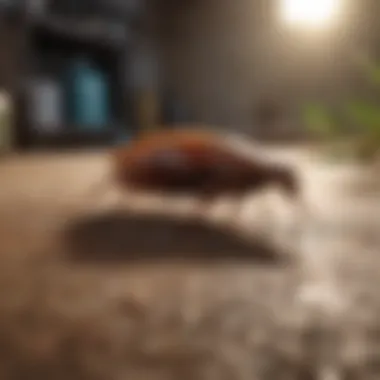Effective Strategies for Safe Roach Elimination


Intro
Roaches are often seen as one of the most unwelcome guests in any home. Their presence can induce feelings of disgust and anxiety. Understanding these insects, including their behaviors and biology, is essential for effectively managing any infestation. In this article, we will explore how to safely eliminate roaches while also considering the safety of occupants and the environment. Implementing the right strategies can help ensure a clean and hygienic living space.
Animal Profile
General Overview
Roaches belong to the order Blattodea and include species such as the German cockroach and the American cockroach. They are resilient insects, capable of thriving in various environments. An adult cockroach can live for months without food but will require water more regularly. Their nocturnal nature makes them more active during nighttime, often seeking food and water in kitchens and bathrooms.
Habitat and Distribution
Roaches are found in nearly all parts of the world, preferring warm, humid environments. They tend to inhabit spaces close to food sources and water. In urban areas, common haunts include basements, kitchens, and behind appliances. Proper sanitation and maintenance of homes are crucial for preventing their infestation, as they are attracted to clutter and unsealed food sources.
Fascinating Facts
Unique Traits and Adaptations
Roaches possess several fascinating biological traits. They can withstand high levels of radiation compared to humans. This resilience is due to their simple body structure and rapid reproduction rates. They can also live without their head for a week, as their nervous system does not rely entirely on the brain.
Historical and Cultural Significance
Throughout history, cockroaches have been subjects of scientific studies and are often seen as indicators of environmental health. Their ability to endure harsh conditions has made them a topic of interest in research related to evolution and survival.
Conservation Status
Current Population Trends
While many people view cockroaches as pests, they play vital roles in ecosystems as decomposers. Current population trends show that certain species are declining due to changing urban landscapes and pest control measures.
Threats and Challenges
Roaches face challenges such as habitat loss and pesticides, which can disrupt their populations. However, they are also highly adaptable, which means they can survive in various environments. This adaptability poses a challenge for effective pest control solutions.
Ending
Understanding the biology and behavior of roaches is the first step in effective pest management. The knowledge gained from this article equips readers to address infestations ethically and safely. By implementing preventive measures and selecting appropriate treatment options, one can ensure a pest-free living environment that considers both safety and ecological balance.
Understanding Roaches
Understanding roaches is crucial in effectively addressing infestations. Knowledge of their biology, common species, and behaviors equips individuals with the tools needed to identify and counteract these pests. It reveals the particular vulnerabilities of roaches, guiding users to apply targeted strategies for elimination.
Biology of Roaches
Roaches belong to the order Blattodea, which includes over 4,600 species. They are characterized by their flattened bodies, long antennae, and rapid reproduction rates. A single female cockroach can produce hundreds of offspring in her lifetime, leading to quick population growth. Their ability to survive in diverse environments makes them particularly resilient.
Roaches have specialized mouthparts that allow them to consume a wide variety of organic matter. This flexibility in diet means they can thrive in both clean and dirty surroundings. Understanding their biology is fundamental to creating environments less conducive to their survival.
Common Species of Roaches
Several species of roaches are commonly found in urban areas. The German cockroach, for instance, is small and predominantly found indoors. It thrives in kitchens and bathrooms, making it a significant nuisance. The American cockroach, larger in size, often infests basements and sewers. There is also the Oriental cockroach, which prefers damp, cooler environments.
Identifying the species is essential to determine the most effective control measures. Each species may respond differently to treatments, leading to varied success rates in eradication efforts.
Behavior and Habits
Roaches are primarily nocturnal creatures, preferring to scavenge for food when it is dark. Their habits are influenced by environmental factors such as light and moisture levels. They tend to congregate in areas with abundant food sources, making kitchens and dining areas prime locations for infestation.


They communicate through pheromones, which helps them locate food and warn others of danger. Their social structure can lead to rapid infestation as they multiply in favorable conditions. Understanding these behaviors assists homeowners and pest control professionals in targeting areas of highest activity.
Knowledge about the biology, species, and behaviors of roaches lays a strong foundation for combatting infestations effectively.
Signs of Infestation
Recognizing the signs of a roach infestation is crucial for effective pest control. Identifying these early warning signs can prevent a minor issue from escalating into a significant problem. Understanding the indicators helps not only in addressing the infestation promptly but also in implementing measures to avoid future occurrences.
Physical Indicators
Physical indicators of cockroach presence include spotting actual specimens. Adult roaches may appear in various sizes depending on the species, typically ranging from one to four inches long. Observing them scurrying across surfaces, particularly during the night when they are most active, is a common sign of infestation.
Additionally, many species prefer dark and damp areas. If you notice roaches around kitchen cabinets, under sinks, or in bathrooms, it is likely evidence of a growing problem. Their tendency to congregate is often noticeable, particularly in areas where food or moisture is available. Regular inspections can help identify these physical signs early on and help in curtailing expansion of their nests.
Fecal Droppings
Fecal droppings are another clear indicator of roach activity. Unlike droppings from other pests, cockroach feces resemble small dark grains or pepper-like specks. The location of these droppings often reveals hotspots of infestation. Common areas to check include under the fridge, near food storage areas, and around garbage bins.
The presence of droppings should prompt immediate action. Fecal matter can also contribute to health risks, as it can trigger allergies and spread disease. Regular cleaning can minimize the risks associated with this contamination. If significant amounts of feces are found, it is a strong signal to consult pest control.
Odors and Skin Shedding
Another often-overlooked sign of cockroach infestations is an unpleasant odor. Roaches secrete chemicals that may produce a musty smell, which can linger in the environment. This odor often becomes more pronounced as the infestation grows. Monitoring for such odors can alert homeowners to underlying issues before they become visible.
In addition, roaches shed their skins as they grow. This molting process leaves behind exoskeletons, which can be mistaken for other debris. Recognizing these shed skins—typically found in the same areas where droppings appear—can confirm roach presence. Regular vigilance for these indicators is essential in maintaining a roach-free living environment.
A proactive approach to monitoring these signs can greatly enhance pest control efforts, leading to a healthier living space.
Health Risks Associated with Roaches
Understanding the health risks posed by roaches is crucial for effective pest control. Roaches are not merely a nuisance; they can contribute to significant health issues. Their presence in living spaces goes beyond discomfort, as they can affect the well-being of residents, especially children and individuals with pre-existing health conditions.
By recognizing the potential dangers, people can take informed steps to mitigate these risks and ensure a safer living environment.
Allergic Reactions
Roaches are known to trigger allergic reactions in many individuals. The primary culprits are not just the roaches themselves, but also their shed skin, feces, and saliva. These allergens can become airborne, leading to respiratory issues when inhaled. Common symptoms include:
- Sneezing
- Coughing
- Itchy eyes
- Skin rashes
In sensitive populations, such as children or those with asthma, these reactions can be severe. Therefore, reducing exposure to roaches can also lower the incidence of allergy-related health issues. One effective strategy is maintaining cleanliness, which removes potential allergens and minimizes the chances of infestations.
Disease Transmission
Roaches are carriers of various pathogens that can lead to disease transmission. They can pick up bacteria, viruses, and parasites from decaying matter and other unsanitary environments. When they move through homes, they leave behind a trail of contamination. Some diseases linked to roach presence include:
- Salmonellosis
- Gastroenteritis
- Allergic diseases
- Asthma exacerbations
These diseases can have severe implications for public health, particularly in densely populated areas. Individuals may unknowingly ingest contaminated food or surfaces, leading to illness. To combat this, it is imperative to implement pest control measures. Keeping food sealed and maintaining hygiene can significantly reduce the risk of disease transmission.
Roaches can impact both health and quality of life. Understanding their health risks is the first step in effective pest control.
By being proactive about these health risks, individuals can foster a healthier environment and potentially save on medical costs associated with roach-related illnesses.
Preventive Measures
Preventing a roach infestation is an essential approach to maintaining a healthy living environment. This section discusses how proactive measures can notably reduce the chances of a roach problem. Effective preventive strategies not only address existing issues but also help to keep roaches at bay, which ultimately contributes to better hygiene and well-being in households.


Maintaining Cleanliness
Kitchen Cleanliness
Kitchen cleanliness is one of the most critical aspects in preventing roaches from invading your home. The kitchen is often the main area where food is prepared and consumed, creating a beacon for these pests. Keeping this space clean involves several strategies: regularly wiping down countertops, cleaning dishes promptly, and ensuring that no food scraps are left on the floor. The key characteristic of kitchen cleanliness is the elimination of food sources that attract roaches. When food is easily accessible, it calls them in.
One beneficial choice in maintaining kitchen cleanliness is the use of airtight containers for food storage. This practice not only protects food from contamination but also reduces odors that might attract roaches. However, neglecting to clean appliance surfaces, such as behind the refrigerator or under the stove, can defeat these efforts. It is crucial to consistently address these hidden areas to thwart potential invasions.
Bathroom Maintenance
Bathroom maintenance complements overall cleanliness and helps deter roaches as well. This space often has moisture and dark corners, making it a suitable habitat for many pests, including roaches. A key aspect of bathroom maintenance includes regularly checking for leaks or standing water, as these conditions provide an ideal environment for roaches to thrive.
Why is bathroom maintenance important? Cleaning surfaces frequently, including sinks and tubs, and managing grime can make the area less inviting. The unique feature of bathroom maintenance lies in eliminating moisture and ensuring proper ventilation, which contributes to a less hospitable environment for roaches. While this is often seen as a straightforward task, many overlook the impact of hiding spots such as under the sink or behind the toilet that could harbor infestations.
Sealing Entry Points
Entry points are vital areas that need attention in roach prevention. Gaps and cracks in walls, floors, and around windows and doors are common entryways for these pests. Sealing these points reduces the likelihood of roaches finding their way into your living space. Regular inspections help to identify where these access points may exist.
Methods to seal entry points include using caulk for small gaps and more durable materials for larger openings. Focusing on these areas mitigates the risk of an infestation and is an effective, low-cost approach to safeguarding your home. A preventative mindset in sealing potential entry paths contributes significantly to overall pest management, enhancing the efforts already undertaken in maintaining cleanliness.
Proper Food Storage
Proper food storage plays a crucial role in roach prevention. Utilizing airtight containers is vital for residual food. Storing excess food in sealed environments minimizes the risk of attracting disturbances from roaches. It is equally important to be mindful of the utensils and appliances used, as residue can accumulate in corners or under items if left unchecked.
The unique feature of proper food storage is that it not only protects food from pests but also promotes ingredient longevity. This practice is not just beneficial for roach control; it also enhances the organization of your pantry. Ensuring that all food is neatly contained can prevent food waste and maintain a clean appearance within the kitchen, facilitating better long-term management against infestations.
Natural Remedies
Natural remedies play an essential role in combating roach infestations, providing safer and environmentally considerate alternatives to harsh chemicals. These methods often leverage ingredients readily available at home or in health stores. Employing natural solutions is important, especially for households with children or pets, where chemical exposure can become a concern.
Using natural remedies not only helps to eliminate roaches but also minimizes the ecological footprint. These alternatives tend to be less harmful to beneficial insects and wildlife, allowing for sustainable pest control. Natural methods often require consistent application and patience, as they may not show immediate results. However, they contribute to long-term management of roach populations, which can be especially advantageous in preventing re-infestation.
Essential Oils
Essential oils are potent and versatile in repelling roaches. Oils such as peppermint, tea tree, and eucalyptus are particularly effective due to their strong scents. To use essential oils, dilute a few drops with water and spray around possible entry points, such as doorframes and kitchen cabinets.
Benefits of using essential oils include their pleasant aroma and lack of toxic chemicals. They also act as a deterrent when dispersed throughout an area. However, it’s essential to note that while essential oils can repel roaches, they may not effectively eliminate existing infestations. Regular application will be crucial in maintaining their efficacy.
Boric Acid
Boric acid is a well-known and effective method for roach control. It acts as a stomach poison for cockroaches. When ingested, it disrupts their digestive systems. You can sprinkle boric acid in areas where roaches are likely to traverse, such as under sinks and behind appliances.
While boric acid is less toxic to plants and animals than many commercial pesticides, caution is still necessary. Keep boric acid out of reach of children and pets. If applied properly, it can provide a prolonged effect as roaches carry it back to their nests, impacting more members of the colony.
Diatomaceous Earth
Diatomaceous earth is a natural powder made from crushed fossilized algae. This substance works effectively against roaches by damaging their exoskeletons, ultimately leading to dehydration and death. Sprinkling food-grade diatomaceous earth in infested areas can create a barrier that roaches cannot cross without suffering consequences.
Using diatomaceous earth is advantageous due to its safety profile and effectiveness. It requires careful application, as it must remain dry to work. Regular monitoring and reapplication can be necessary, especially in areas prone to moisture. It is crucial to use food-grade diatomaceous earth, as industrial-grade can be harmful.
When combining natural remedies, consistency and a multi-faceted approach can yield optimal results. Regularly rotate or alternate methods to keep pests from developing resistance.
Chemical Solutions
Chemical solutions play a significant role in managing roach infestations. They offer a variety of options that can effectively reduce and even eliminate the presence of these pests. Understanding these solutions can help individuals make informed decisions that prioritize safety and efficacy while addressing the issue at hand.
The use of chemical solutions often provides immediate results. Unlike natural remedies, which may take longer to show effects, chemical insecticides can quickly lower roach populations. However, their use must be approached thoughtfully. It is essential to carefully consider the potential health implications for both residents and pets, as well as the environmental impact of these substances.


Different chemical options vary in terms of effectiveness and safety. When selecting a product, it's crucial to read label instructions and safety warnings. Selecting the right chemical solution ensures effective pest control while minimizing potential risks.
Best Practices During Treatment
Understanding best practices during the treatment of a roach infestation is essential for achieving successful results. It outlines the proper steps to handle the situation safely and effectively. Implementing these practices minimizes health risks, ensures the efficiency of chosen methods, and promotes long-term pest control.
Safety Precautions
Safety should be the first concern when dealing with roaches. Whether you are using chemical treatments or natural remedies, it is vital to protect yourself and others in your vicinity.
- Personal Protective Equipment (PPE): Wear gloves, masks, and goggles. This helps prevent contact with harmful substances or allergens.
- Ventilation: Ensure adequate ventilation in the area where you are applying treatments. Open windows and doors to allow fresh air to circulate, which may help disperse any chemical odors.
- Avoid Overexposure: Follow label instructions carefully. Misusing pesticides can lead to harmful exposure.
- Household Safety: Keep children and pets away from treated areas until it is safe. This is critical for preventing accidental ingestion or exposure to harmful substances.
By adhering to these precautions, you safeguard your health and the wellbeing of your household during the treatment process.
Post-Treatment Cleanup
After treatment, a thorough cleanup is essential to remove any residues left behind and maintain a healthy living environment. Proper cleaning plays a critical role in ensuring effective pest control and preventing potential re-infestations.
- Remove Residues: Clean the treated areas with mild detergent and water. This assists in eliminating any remnants of pesticides or natural treatments used.
- Dispose of Bait Stations and Traps: Once you have assessed their effectiveness, remove and discard any used bait stations and traps safely to prevent accidental contact.
- Sanitize Areas: Focus on areas where food is prepared or stored. A clean environment helps reduce the attraction for roaches and can diminish their chances of returning.
- Monitor for Signs of Roaches: After cleanup, continue to inspect regularly. Catching any new signs early ensures that you can respond promptly if there is a resurgence.
Regular cleanup and monitoring keep your home safer and help ensure long-term effectiveness of your treatment strategies.
By following these best practices during and after treatment, you establish a solid framework for effectively managing roach infestations. An understanding of safety measures and thorough cleanup routines contributes to a successful pest control strategy.
Monitoring and Maintenance
Monitoring and maintenance are crucial components of an effective strategy for managing roach infestations. These steps ensure that any signs of roach activity are detected early and that preventive measures remain effective over time. A proactive approach allows for the identification of potential issues before they escalate, thereby reducing the likelihood of a significant infestation.
Regular Inspections
Regular inspections should be part of the routine in any environment susceptible to roaches. This includes homes, schools, and businesses. Inspecting for signs of activity, such as droppings or egg casings, helps indicate whether roaches are present. It is necessary to check high-risk areas like the kitchen, bathrooms, and basements.
The following checklist can help with inspections:
- Look for droppings under sinks and cabinets.
- Check for any evidence of grease stains along walls or edges of surfaces.
- Examine cracks and crevices for signs of nesting.
- Keep track of any sightings of live or dead roaches.
Consistent inspections allow for timely action. If signs are observed, immediate measures can be taken to address the problem. Additionally, documenting inspection findings can help identify patterns over time.
Continuous Preventive Measures
Continuous preventive measures are vital to maintaining a roach-free environment. Regular cleaning is one of the most effective ways to deter these pests. This includes:
- Wiping down surfaces to remove food particles.
- Emptying garbage bins frequently and ensuring they are sealed.
- Storing food in airtight containers.
Other preventive strategies include:
- Sealing entry points where roaches might enter. Examine windows, doors, and utility pipes for gaps.
- Reducing humidity, as cockroaches thrive in moist conditions. Use dehumidifiers if needed.
- Using natural and chemical repellents, as needed.
Monitoring and maintenance, through inspections and preventive measures, play a central role in the long-term success of roach control efforts. Keeping a vigilant eye can lead to a cleaner, healthier space, free of the risks associated with a roach infestation.
Regular monitoring and proactive maintenance are key to ensuring a sustainable roach control strategy.
End
The conclusion of this article emphasizes the critical aspects of effective roach control. Throughout the comprehensive analysis, we have explored the biological aspects, signs of infestation, health risks, preventive measures, and treatment options, both natural and chemical. This multifaceted approach not only aids in understanding how to safely eliminate roaches but also highlights the need for consistent diligence in maintaining a roach-free environment.
Summation of Key Points
- Understanding Biology and Behavior: Knowing the biology and habits of roaches is vital. This knowledge enables proactive measures to prevent infestations.
- Health Risks: The presence of roaches is more than just an inconvenience. They pose serious health risks through allergenic reactions and the transmission of diseases.
- Preventive Strategies: Maintaining cleanliness and sealing entry points are essential steps. These measures reduce the likelihood of infestation significantly.
- Treatment Options: Exploring both natural and chemical methods provides flexibility. Individuals can choose what best aligns with their health and environmental concerns.
- Continuous Monitoring: Regular inspections of the living space and continued preventive efforts ensure that roaches remain at bay.
Final Thoughts on Roach Control
"An informed approach leads to better outcomes in controlling roach populations."
Ultimately, maintaining vigilance in prevention and response methods is not just a recommendation but essential for safeguarding homes against roaches and the myriad of risks they present.















